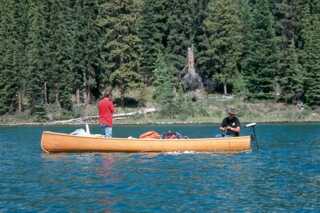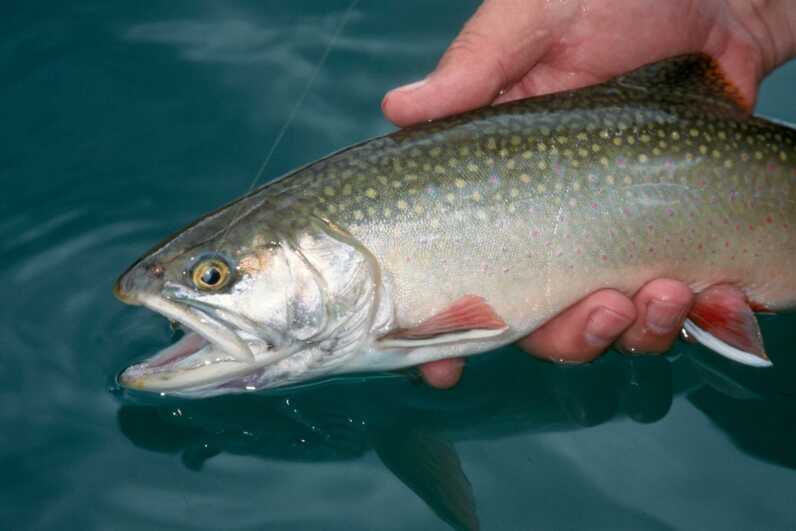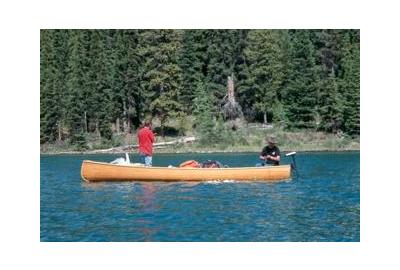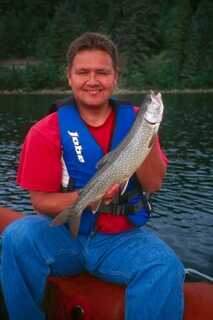Depending on the time of year, the streams may be riding high carrying a load of silt down from the mountains. If they're high, the options are pretty clear, go lake fishing, which is what I will concentrate on. Going fishing in the National Parks is mostly a trout affair. There are opportunities to catch northern pike in Talbot Lake and there are whitefish in some of the other lakes, but really, the park lakes mean trout. To catch them is matter of focus.


I've fished lakers in the Parks, mostly at Pyramid Lake near Jasper and I've had amazing success using nothing more than a non-lead jig slowly worked along bottom.
I've also pulled small Williams Wobbler spoons behind 2.5 ounce bottom bouncers with great success. It seems with lakers, it's all about finding them first. I'll move around in my boat keeping a sharp eye to the sounder until it picks up deeper water fish signals. They're usually lakers. When I see that, I drop on of the two I mentioned above to the bottom and see what's biting. Usually, with a little scanning on the depth sounder I can quickly find out where the lakers are and start fishing. Typically, by the end of June the lakers at Pyramid Lake have gone to the deepest parts of the lake and I'll regularly be picking them up in 46 to 59 feet of water.
In the spirit of experimenting, I've been tinkering with all kinds of lures and found another one that really got the lakers excited. It's the small Apex Hotspots. This little plastic lure that darts from side to side were originally made for salmon, but are right at home with lakers.
I've been getting real good results using the lighter colored ones and use them with that same bottom bouncer. As long as the lakers keep chewing on them, I'll be continuing to put them down.


When it comes to rainbows and brookies I use the one, two, three approach and this totally depends on the day. Usually I'll start the day trolling and cover the water pulling a fast sink line, trolling large streamer like flies. Wooly buggers, fullbacks and 52 Buick's are good starters to name a few. If the trolling is working I may stick with it much of the day, but I also like to hunt for trout so I will often go looking for trouty looking water and settle in over a specific spot on the lake.
When it comes to mountain lakes the one thing I look for is shallow flats. These flats are the food buffet table of the fish world and this is where the action is. Shallow flats can mean different things to different people so for clarity, any bottom that slopes gradually from shore that's 20 feet deep or less I consider a shallow flat. When I find one I look for a couple things. One, little to no wind and two, possible structure, be it weeds or a rock pile. I'll work the edges of both with much attention and work it from the bottom to the top.
Starting with the bottom it's going with small jigs or bust. A small jig dragged on the bottom looks a lot like a caddis fly nymph crawling along. When trout see this, they're quick to charge over and inhale it. Jigs can be slowly jigged below the boat if it's deeper, say more than 12 feet, so not to spook any fish. Otherwise I'll often cast a jig and drag it slowly on bottom to great results. The other system is hanging a small bead head nymph under a bobber. The rigging can take on all kinds of contortions, but rather than get sneaky I'll keep it simple.
I'll set up a full on slip bobber rig at depths in increments from shallow to deep and back again working all levels of the water column. For example, I'll be anchored in 15 feet of water. On my first cast I'll set the depth to 6 feet. If no bites I'll put the next cast out at 8 feet and then at 10 feet until the fish bite. When they do, I'm off to the races. I'll keep fishing that depth until the bite cools, which sometimes never happens. If it does, however, a short move, even 50 feet down the lake will often put me right back into the action.
Fishing in the mountains is just coming into its prime. Combine a camping trip to the Rockies with a little fishing and you'll be set for a great weekend vacation.





